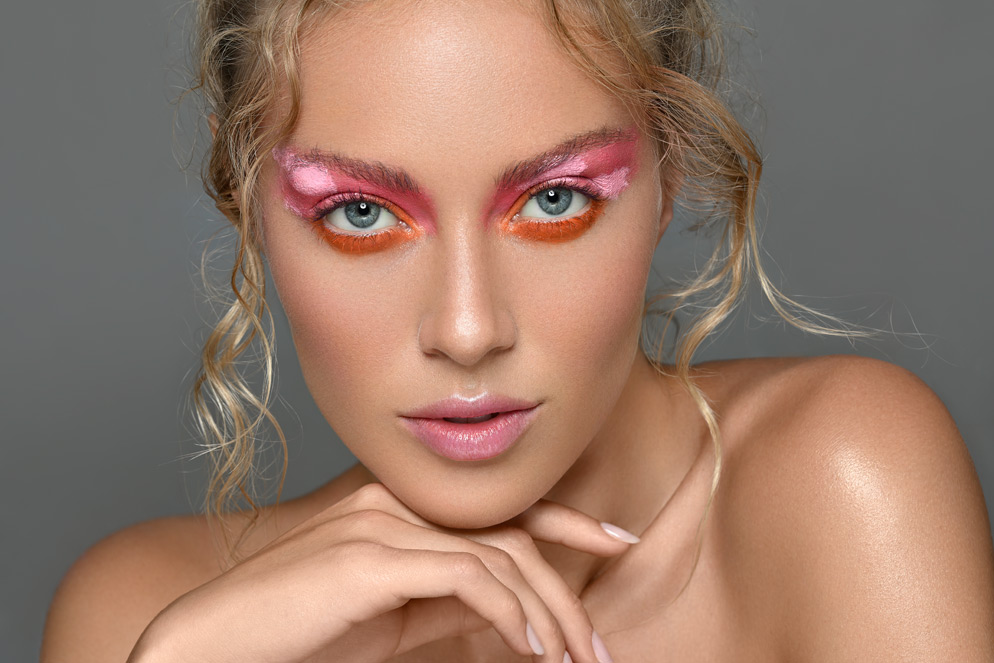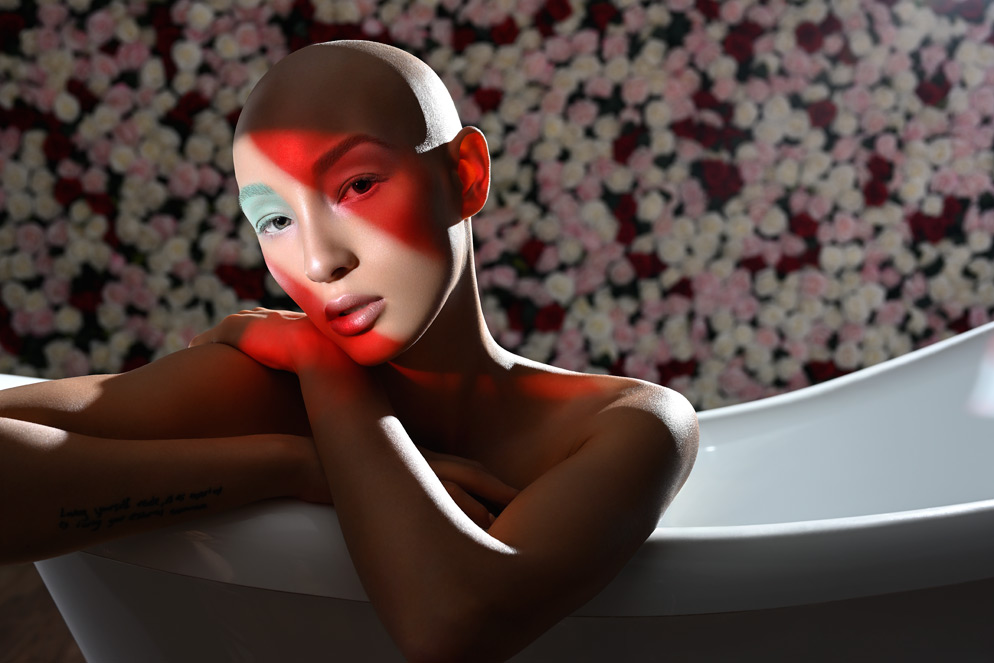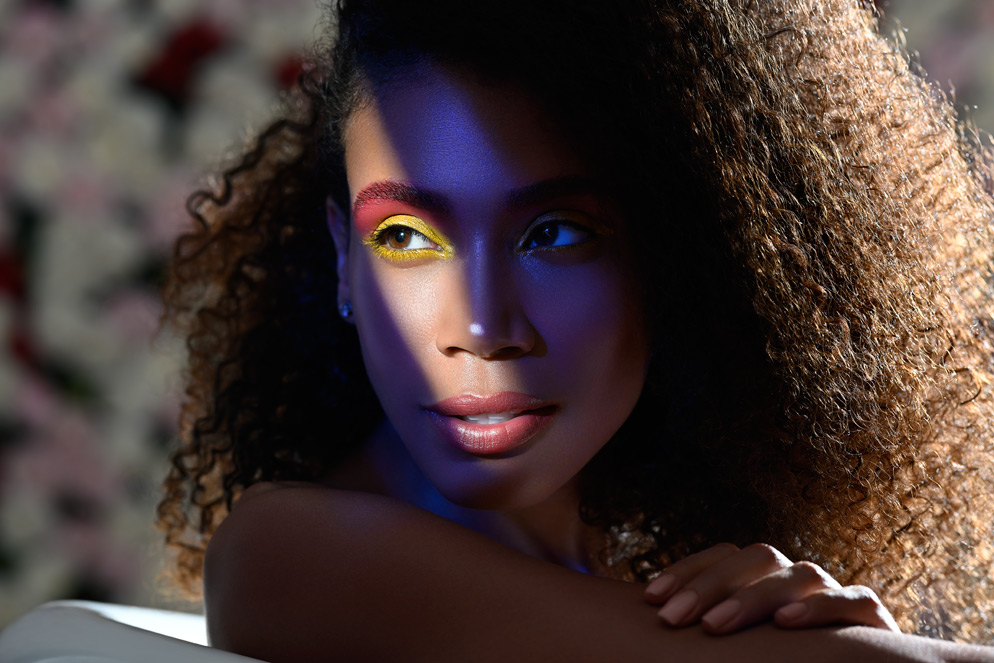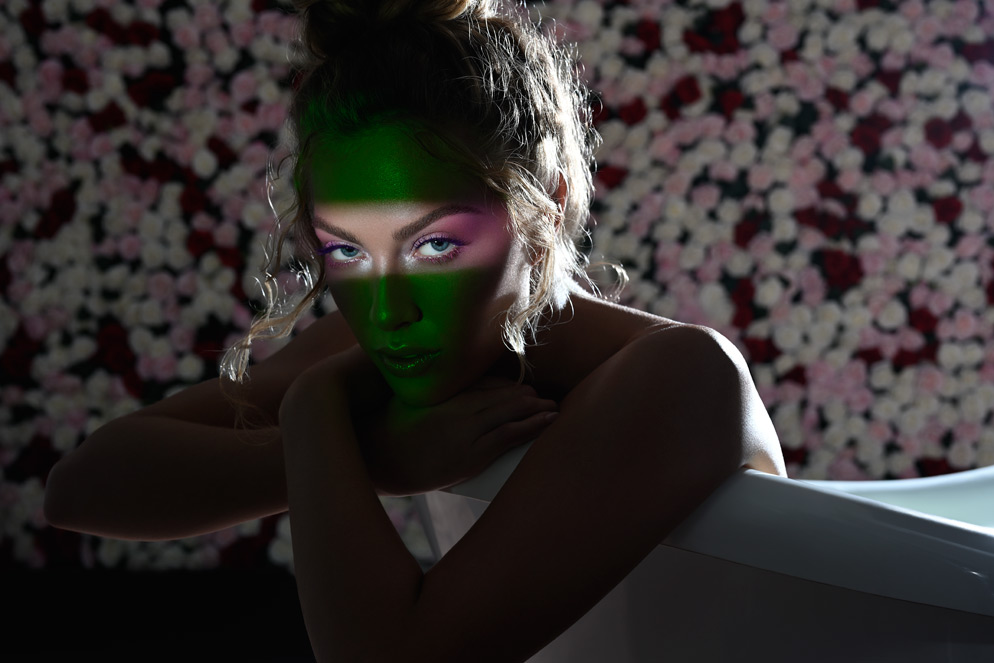Z 7: Under Pressure
One of a series of tests of the Z 7 to show color rendition, this image was shot using one studio light behind the model. Matthew's assistant stood next to the camera holding a mirror on which color gels were fixed. "So the back light becomes the front light because of the mirror," Matthew says. "I played around with this idea in tests, and used it for this assignment." Z 7, NIKKOR Z 50mm f/1.8 S, 1/200 second, f/7.1, ISO 64, manual exposure, Matrix metering.
I wanted to check out the camera in real-world situations, so I just took it to work, and it's been an absolutely mind-blowing camera for me.
Nikon Ambassador Matthew Jordan Smith's early use of the Z 7 coincided with a particularly busy time for him. "There were two trips to LA for shoots, two to New York," he says. "There were celebrity jobs with time limits where I'd be using the camera in pressure situations."
Frankly, he expected he'd be using his workhorse D850 for most of the photography, which is exactly what didn't happen. He did some back and forth switching, but overall he barely touched the D850, as the new camera fit right in with Matthew's skills and style.
"The Z 7 was a little different than the D850," he says, "but for the most part when I looked at its menu, I knew everything I needed to know. I loved that I could use all my lenses with it, and I didn't miss a beat."
In fact, the camera's performance during three weeks of shooting opened up the possibilities of some new and better beats.
Matthew's favorite elements here are the indigo shadows. "I didn't want just dark shadows, I wanted more energy, and the gels on the mirror did it. We took several shots, changing the size of the shadows by changing the size of the gels." Z 7, Mount Adapter FTZ, AF-S NIKKOR 105mm f/1.4E ED, 1/200 second, f/5.6, ISO 64, manual exposure, Matrix metering.
Beyond Expectations
In the hands of pro photographers, the Z 7 had a high bar to clear, and Matthew's expectations were typical. "The Z 7 is a Nikon, so at the very least I expected a camera that was definitely on par with the D850, which has been an amazing camera for me."
Okay, D850-like—a good start. And, of course, it's smaller and lighter than a DSLR—but that was a given. To clear the bar, it had to be a whole lot more, and for Matthew, and so many others, it was.
First, it was 45.7-megapixel powerful. Second, there was the the Mount Adapter FTZ that insured compatible NIKKOR AF-S and earlier F-mount lenses would be compatible. So far, so good, but still, only the basics.
Then Matthew latched onto the nine-frames-per-second continuous shooting capability and the Z 7's autofocus coverage of 90 percent of the image area. For him, this was big-deal territory.
"The ability to go edge to edge with composition—I had no idea they'd be doing that. I've been used to shooting the old fashioned way—lock focus and recompose. To have focus exactly where I want it is a game changer for me."
A test of the camera's ability to capture details in the shadows. The prop bathtub in this and the previous photos is designed for sets, not for bathing. Z 7, 1/200 second, NIKKOR Z 50mm f/1.8 S, f/7.1, ISO 64, manual exposure, 3D Color Matrix metering.
Extremely important was that with the new camera there was no reason or need to change his style of shooting or the style and substance of his images. "I shoot fast," Matthew says, "and the camera was responding right away—I felt no difference between the Z 7 and the D850 during the times I was going back and forth on the job."
At one point he shot a weekend's worth of images wide open with the NIKKOR Z 50mm f/1.8 S and his AF-S NIKKOR 105mm f/1.4E ED. "It was amazing. The way they've designed the optics [of the native lenses and the adapter], I think I was getting sharper photos than I ever had before. That 50mm is so super sharp people aren't going to believe it 'til they see it."
The "beyond expectation" factors added up to exceptional images that showcased subtle transitions of light and color. They were photos of no-noise perfection, with detail in shadow areas and radiant, nuanced skin tones.
Later on, with some time for himself, Matthew shot at a street music festival where he put the Z 7 to some additional tests amid fast-moving performers and participants. "I got to see how great the viewfinder is. I went from bright sunlight into night—tracking was amazing, and the viewfinder was brighter than reality. I've never seen anything like that before."
It was a quick transition for Matthew to add the Z 7 to his gear.
"There's a learning curve for anyone using a mirrorless camera for the first time," he says, "but you learn that pretty fast.
"And it's a camera that does things we couldn't do before."
An image that's all about the rendition of colors and skin tones. The light for this and the following image was Matthew's Profoto Beauty Dish. Z 7, Mount Adapter FTZ, AF-S NIKKOR 105mm f/1.4E ED, 1/200 second, f/11, ISO 64, manual exposure, Matrix metering.
Motion Pictures
It's also a camera that's going to encourage him to do something he was hesitant to do before.
"That's another thing I was not expecting," Matthew says. "I always wanted to shoot video, and I'll be honest, manual focus has been the one thing that's kept me away from diving deeper into it. It was a hindrance for me, and now that's become history. This camera is incredible for video."
He's already made a little night-time video, focusing on people walking into the scene, staying with them as they talk, then switching to another person. "I was using pinpoint focus, setting it from the touch screen, tracking people wherever they went, then touching another point in the scene and having it fade into focus in that area—It was smooth and seamless."
He plans to have an additional Z 7 body just for video, but he's not waiting to get it to start thinking like a video maker. "I'm flying out of New York this afternoon, and I’m going to be working on a storyboard on the plane."
Which makes the Z 7, in addition to its other attributes, the "expand your repertoire" camera.
Matthew photographed all the images for the Z 7 color test hand-held. "I like to roam around, and most often I'm not tethered to a monitor and don't check the images as I go." Z 7, NIKKOR Z 50mm f/1.8 S, 1/200 second, f/10, ISO 64, manual exposure, Matrix metering.










